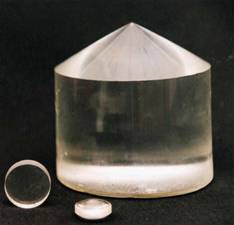LiF
LiF shows excellent transmittance in the VUV region. It is used for windows, prisms, and lenses in the visible and infrared in 0.104 μm - 7 μm. LiF is sensitive to thermal shock and would be attacked by atmospheric moisture at 400 °C. In addition irradiation produces color centers. Modest precautions should be taken against moisture and high energy radiation damage. Besides LiF is softens at 600 °C and is slightly plastic that can be bent into radius plates. The material can be cleaved along (100) and less commonly (110). Although the optical characteristics are good the structure is not perfect and cleavage is difficult. For good structure LiF is less commonly grown by the Kyropoulos method (air-grown) specifically for monochromator plates. High quality LiF is usually grown by modified Bridgman technique. Maximum available size in diameters is 115mm. LiF is slightly plastic and can be bent into radius plates.
Product Presentation
Main Properties of LiF crystal
Density | 2.64g/cm(3) |
Melting Point | 870℃ |
Molecular Weight | 25.9394 |
Lattice Constant | 4.0279 Å |
Thermal Conductivity | 4.01 W/(m K) |
Specific Heat | 1562 (J kg(-1) K(-1)) |
Thermal Expansion | 28.1 - 34.8 (10(-6)/K) |
Hardness (Knoop) | 102–103kg/mm(2) |
Hardness (Mho) | 3 |
Young’s Modulus | 64.79GPa |
Shear Modulus | 55.14 GPa |
Bulk Modulus | 62.03 GPa |
Rupture Modulus | 10.8 MPa |
Elastic Coefficient | C11 = 112 / C12 = 45.6 / C44 = 3.2 GPa |
Poisson's Ratio | |
Crystal Type | Fm3m ,cubic, NaCl type structure |
Dielectric Constant | 9.0 @ 25 °C, f = 100...109 Hz |
Solubility in Water | 0.27 (g/100 cm(3)) @ 18 °C |
Application | VUV,DUV |



 闽公网安备35018102000755号
闽公网安备35018102000755号